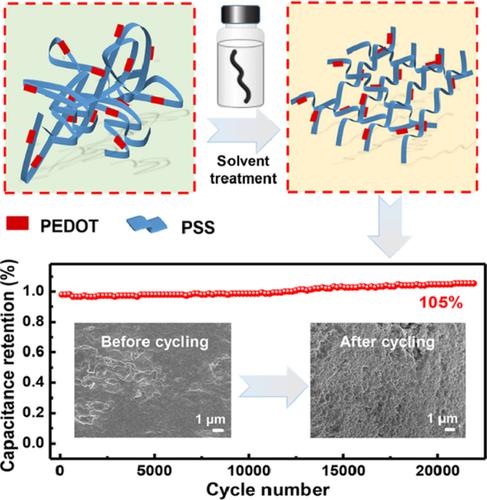当前位置:
X-MOL 学术
›
Int. J. Energy Res.
›
论文详情
Our official English website, www.x-mol.net, welcomes your
feedback! (Note: you will need to create a separate account there.)
Solvent treatment inducing ultralong cycle stability poly(3,4‐ethylenedioxythiophene):poly(styrenesulfonic acid) fibers as binding‐free electrodes for supercapacitors
International Journal of Energy Research ( IF 4.3 ) Pub Date : 2020-03-24 , DOI: 10.1002/er.5352 Guoqiang Liu 1 , Fengxing Jiang 1 , Jing Liu 1 , Congcong Liu 1 , Jingkun Xu 1, 2 , Qinglin Jiang 3 , Nan Zheng 3 , Guangming Nie 2 , Peipei Liu 1, 3
International Journal of Energy Research ( IF 4.3 ) Pub Date : 2020-03-24 , DOI: 10.1002/er.5352 Guoqiang Liu 1 , Fengxing Jiang 1 , Jing Liu 1 , Congcong Liu 1 , Jingkun Xu 1, 2 , Qinglin Jiang 3 , Nan Zheng 3 , Guangming Nie 2 , Peipei Liu 1, 3
Affiliation

|
As one kind of conducting polymer composite, poly(3,4‐ethylenedioxythiophene):poly(styrenesulfonic acid) (PEDOT:PSS) has been widely used as an electrode for energy storage and conversion devices because of its optical transmittance, flexibility, and high electrical conductivity etc. Here, we prepared binding‐free PEDOT:PSS fibers (PFs) electrodes with high capacitive performance for supercapacitors via a facile method followed by various solvent treatments. Dimethyl sulfoxide (DMSO)‐treated electrodes displayed a better specific capacitance (Cs) of 202 F/g at 0.5 A/g with higher elongation at break, flexibility, and conductivity of 140.7 S/cm, compared to those of pristine PEDOT:PSS materials. More importantly, the DMSO‐treated fibers possessed improved stability, which retained 105% of the initial Cs after 22 000 long cycles at 10 A/g. It is believed that the fabricated PFs will be promising organic electrodes for portable supercapacitors and other flexible electronic devices in the near future.
中文翻译:

溶剂处理诱导超长周期稳定性的聚(3,4-乙撑二氧噻吩):聚(苯乙烯磺酸)纤维作为超级电容器的无粘结电极
聚(3,4-乙撑二氧噻吩):聚(苯乙烯磺酸)(PEDOT:PSS)作为一种导电聚合物复合材料,由于其透光性,柔韧性和高的导电性而被广泛用作储能和转换装置的电极。在这里,我们通过一种简便的方法,随后进行了各种溶剂处理,为超级电容器准备了具有高电容性能的无粘结PEDOT:PSS纤维(PFs)电极。二甲基亚砜(DMSO)处理的电极显示出更好的比电容(C s)与原始PEDOT:PSS材料相比,在0.5 A / g时为202 F / g),断裂伸长率,柔韧性和电导率更高,为140.7 S / cm。更重要的是,经DMSO处理的纤维具有更高的稳定性,在22 000个长循环下以10 A / g的速率保留了初始C的105%。据信,在不久的将来,所制造的PF将成为用于便携式超级电容器和其他柔性电子设备的有机电极。
更新日期:2020-03-24
中文翻译:

溶剂处理诱导超长周期稳定性的聚(3,4-乙撑二氧噻吩):聚(苯乙烯磺酸)纤维作为超级电容器的无粘结电极
聚(3,4-乙撑二氧噻吩):聚(苯乙烯磺酸)(PEDOT:PSS)作为一种导电聚合物复合材料,由于其透光性,柔韧性和高的导电性而被广泛用作储能和转换装置的电极。在这里,我们通过一种简便的方法,随后进行了各种溶剂处理,为超级电容器准备了具有高电容性能的无粘结PEDOT:PSS纤维(PFs)电极。二甲基亚砜(DMSO)处理的电极显示出更好的比电容(C s)与原始PEDOT:PSS材料相比,在0.5 A / g时为202 F / g),断裂伸长率,柔韧性和电导率更高,为140.7 S / cm。更重要的是,经DMSO处理的纤维具有更高的稳定性,在22 000个长循环下以10 A / g的速率保留了初始C的105%。据信,在不久的将来,所制造的PF将成为用于便携式超级电容器和其他柔性电子设备的有机电极。











































 京公网安备 11010802027423号
京公网安备 11010802027423号